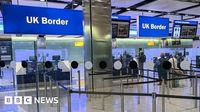Britain’s migration story has taken another unexpected turn. Revised figures released by the Office for National Statistics (ONS) this week reveal that net migration to the UK in 2024 was 20% lower than previously believed, dropping the headline number by 86,000 to 345,000. This substantial revision, as reported by BBC and other outlets, comes just as political leaders and the public alike grapple with the complexities of Britain’s post-Brexit borders and the true scale of population shifts.
The ONS’s adjustment is more than just a statistical footnote. At its core is a newfound realization: far more British nationals left the UK in 2024 than officials had first recorded, with 100,000 fewer Britons now thought to be living in the country. The new methodology, which moves away from the pre-pandemic practice of surveying a small sample of airport and port passengers, instead relies on how often individuals appear in tax and benefits records. This shift, ONS officials argue, provides a more accurate and active snapshot of who is living and working in the UK at any given time.
According to the revised figures, 257,000 British nationals emigrated from the UK in 2024, while 143,000 Britons living abroad returned. That results in a net emigration of 114,000—a dramatic increase from the initial estimate of just 17,000. As Dr. Madeleine Sumption, director of the Migration Observatory think tank, told BBC, “The results obtained by the old method were implausibly low for British nationals.” She cautioned, however, that the new figures are "still not final" because they don’t directly measure border crossings. If a person remains in the UK but disappears from tax and welfare data—perhaps living off savings—they could be mistakenly counted as an emigrant, potentially skewing the numbers.
The changes aren’t limited to British nationals. The way the ONS measures EU+ migration (covering all 27 EU countries plus Iceland, Liechtenstein, Norway, and Switzerland) has also shifted. Instead of relying on Department for Work and Pensions data, the ONS now uses Home Office Borders and Immigration data—a system already in place for non-EU nationals since 2021. This is a more direct method, as EU+ nationals now require visas or leave to remain, making their movements easier to track. The revised estimate now puts the decline in EU citizens living in the UK at 69,000 by the end of 2024, down from the previous figure of 96,000.
These technical adjustments have had a tangible impact on the UK’s overall migration narrative. Net migration peaked at a higher and slightly earlier level than previously thought—944,000 in the year ending March 2023, compared to the earlier estimate of 906,000 by June 2023. Yet, the drop that followed was sharper than anticipated, with the latest 12-month total of 345,000 marking the lowest figure since June 2021. The cumulative net migration between 2021 and 2024 has also been revised downward, now estimated at 2.55 million, rather than the previous 2.65 million.
But what’s behind these peaks and valleys? Critics and analysts alike point to a trio of policy changes introduced under Boris Johnson’s government since 2021. The first: a significant increase in work visas, especially in health and social care. Second: a surge in student visas. And third: the opening of humanitarian routes for people fleeing crises in Ukraine, Hong Kong, and Afghanistan. Add to that the persistent rise in small boat crossings—39,075 people have crossed the Channel so far in 2025—and it’s clear that migration pressures have continued to mount, regardless of the government in power.
Successive Conservative governments have repeatedly pledged to bring migration down. When the latest peak was revealed, Conservative leader Kemi Badenoch admitted, “We recognise immigration was too high.” She went on to say, “Once those figures came out we actually put in quite a few measures to bring immigration down. It was because people took their eye off the ball, allowing bureaucrats to manage our borders—that was not what people voted for when they voted to leave the EU.”
Labour, meanwhile, has argued that high migration “reduces the incentives for businesses to train locally,” as stated in their most recent manifesto. In May, Prime Minister Sir Keir Starmer announced a raft of measures aimed at ensuring net migration falls “significantly” over the next four years. Among the proposals: banning recruitment of care workers from overseas, tightening access to skilled worker visas, and raising the costs to employers. Both parties, it seems, are vying to convince voters that they have the answer to Britain’s migration puzzle.
Some of the most dramatic policy shifts have targeted asylum seekers and irregular migration. Former Prime Minister Rishi Sunak introduced restrictions on the rights of students and care workers to bring family members to the UK. And just this week, Home Secretary Shabana Mahmood announced sweeping changes to the asylum system, which she described as “out of control and unfair.” In a pointed warning to Parliament, Mahmood said, “If we fail to deal with this crisis, we will draw more people down a path that starts with anger and ends in hatred.”
The ONS’s overhaul of its migration estimation methods has been years in the making. The International Passenger Survey, once the backbone of migration statistics, was based on a small sample and had become “stretched beyond its original purpose,” as ONS officials put it. The 2021 census further confirmed that the survey was underestimating the number of British people abroad. In response, the ONS began using national insurance data from the Department for Work and Pensions to better estimate the movements of British nationals—a change that has produced much larger, and arguably more plausible, migration numbers.
Still, the new system is not without its critics. Mary Gregory, director of population statistics at the ONS, acknowledged the challenges: “Understanding the long-term international migration patterns of British nationals has been, and always will be, challenging due to the sheer number of British people crossing the border on a daily basis.” Georgina Sturge, a research affiliate at Oxford University’s Migration Observatory, noted that the new method “almost certainly gives a more accurate picture of migration but uncertainties remain.” She added, “The method for estimating migration of British citizens is very much experimental and future revisions are likely. But it is reassuring that the British emigration figure is now more plausible than previous estimates.”
As the country awaits the next release of long-term international migration statistics—due on November 27, 2025—the debate over migration’s role in Britain’s economy, society, and politics is far from settled. What is certain is that, with every revision, the story grows more complex, and the stakes remain as high as ever for policymakers and the public alike.
For now, the latest ONS figures offer a sharper, if still evolving, picture of migration’s ebb and flow—a reminder that in a changing world, even the numbers aren’t set in stone.





